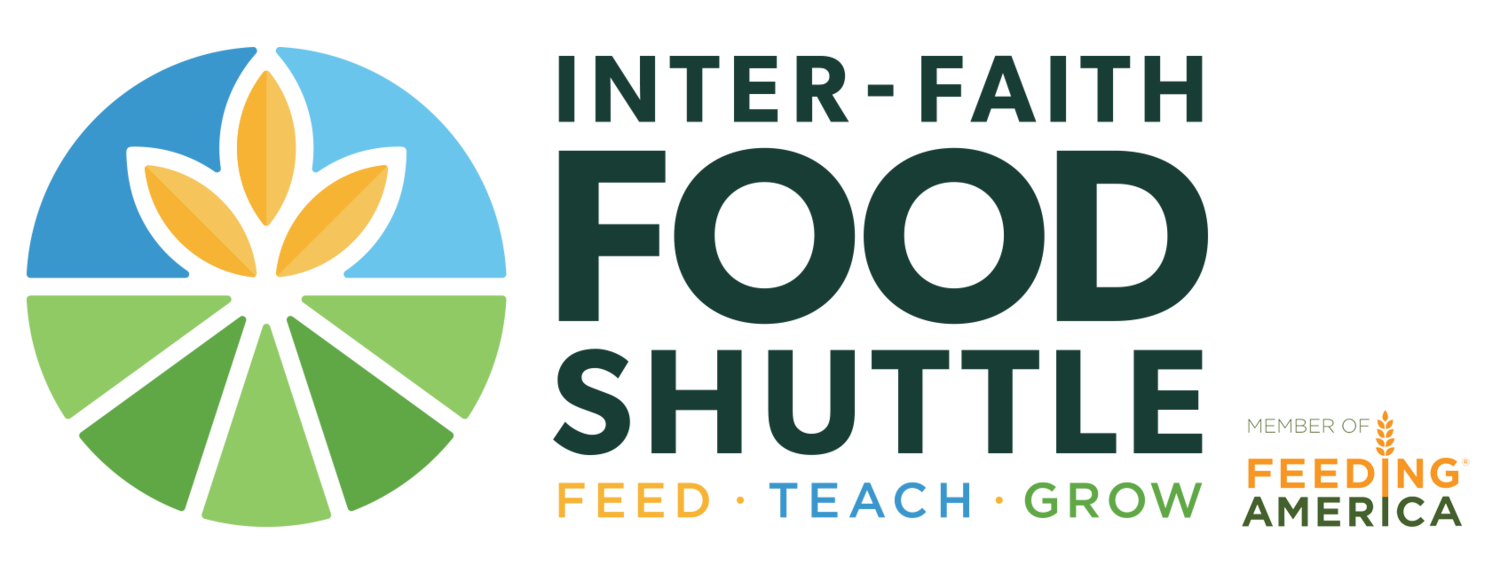[box type="note" size="medium" align="right"]
- View photo gallery from the September tours
- Learn more about Cooking Matters at the Store
- Email Elizabeth (MobileNutrition@FoodShuttle.org) about taking a tour, or volunteering at upcoming tours
[/box]
It’s a struggle everyone can relate to. The grocery store is intimidating. Rows upon rows of products, each clamoring for your attention – and your precious dollars.
With prices ever rising, it can be challenging enough to feed a household without breaking the bank. Taking nutrition content into consideration while filling a cart can make grocery shopping even more daunting.
That’s where Inter-Faith Food Shuttle’s Nutrition Educators step in. They work with Share our Strength’s Cooking Matters at the Store curriculum to provide hundreds of people each year with the skills and know-how to confidently walk the aisles of a grocery store and fill their carts without emptying their wallets.
“A huge challenge our participants face is that the easily accessible foods – the ones that are cheapest – are high calorie foods, such as junk foods and processed foods. And you find those in the center aisles of the grocery store,” said IFFS Mobile Nutrition Programs Coordinator Elizabeth Weeks. “We teach to shop around the perimeter of the store for produce and proteins, and how to identify nutrient dense foods instead of energy dense, high calorie foods.”
This September, the IFFS Nutrition Education team partnered with several volunteers to run grocery store tours each Thursday of the month, over two-dozen tours in total, at a Raleigh Food Lion. Together they were able to teach 220 participants new tips for shopping healthy on a limited budget.
“We run tours at Food Lion because they are one of the most accessible and affordable grocery store chains in the Southeast Raleigh region,” said Weeks. “It’s where many of our participants shop anyway, so touring at Food Lion makes it more applicable to their everyday life.”
The 90-minute tour covers food groups, comparing fresh vs. canned vs. frozen produce, reading food labels and ingredients, and using unit prices to find the best buy.
“Unit pricing is a huge thing,” said Weeks. “Once participants realize they can compare using pounds instead of the retail prices, they’re able to see what they are getting for the money.”
 For example green beans (like many products) are sold in a variety of different sizes and styles, which are not easily comparable. Comparing cost per pound reveals that fresh green beans are typically listed as 1.99 per pound, the frozen green beans are listed as $1.02 per pound, and the canned are less than $0.74 per pound.
For example green beans (like many products) are sold in a variety of different sizes and styles, which are not easily comparable. Comparing cost per pound reveals that fresh green beans are typically listed as 1.99 per pound, the frozen green beans are listed as $1.02 per pound, and the canned are less than $0.74 per pound.
“Looking at the cost per pound instead of the cost on the sticker helps us find the best buy,” said Weeks. “It makes a real difference.
“Many of our participants come into the tour thinking fresh is always the way to go. Really there are many pros to canned and frozen produce, since they are packaged during their nutrient peak. Fresh produce could be shipped from far away or exposed to chemicals during travel. Then you end up paying for transportation and other costs.”
Each tour finishes up with the ‘$10 Challenge.’
“The $10 challenge is an opportunity to use the tools our participants learned on the tour, such as eating from every food group but also choosing healthy options, which is what we like to encourage,” explained Weeks.
Participants receive a Food Lion gift card to buy one healthy item from each My Plate food group – for example, a whole grain, a low-fat dairy, a fruit, a vegetable, and a lean protein – all for under $10.
“They price it all out on their own and can get it under $10 pretty easy, said Weeks. “Some even complete the challenge for under $7 or $8!”
Food Lion generously donates the gift cards, as part of their corporate focus on hunger relief through the #FoodLionFeeds campaign.
“Food Lion supports the programming through access to the store locations and gift cards,” said IFFS Director of Nutrition Education Jill Brown. “It ties in well with their corporate focus.”
At the end of their tour, participants leave with a new set of smart shopping skills, a workbook filled with tips and recipes, their groceries from the $10 challenge, and a reusable grocery bag.
"I learned that frozen vegetables are in some cases more nutritional than fresh ones," said one tour participant who "really liked this tour."
"I learned about shopping in bulk and actually paying attention to the back label," said a second participant.
Other participants reported learning that "store brands are cheaper and just as healthy" and that "buying in bulk and in season is really important."
“These tours empower our participants with the tools to shop healthy on a budget on their own by comparing unit prices, reading ingredient labels, and reading nutrition facts to identify what is in the food they are buying,” said Weeks.
The IFFS Nutrition Division will be running more grocery store tours on October 24 to celebrate Food Day, a nationwide celebration and a movement for healthy, affordable, and sustainable food. Volunteers are needed to lead tours, assist with tours, or assist with registration at four Wake County Food Lion locations. If you are interested, please contact Elizabeth Weeks (MobileNutrition@FoodShuttle.org or 919-561-7188).
By Lindsay Humbert, IFFS Digital Media Specialist. Contact: Lindsay@foodshuttle.org



